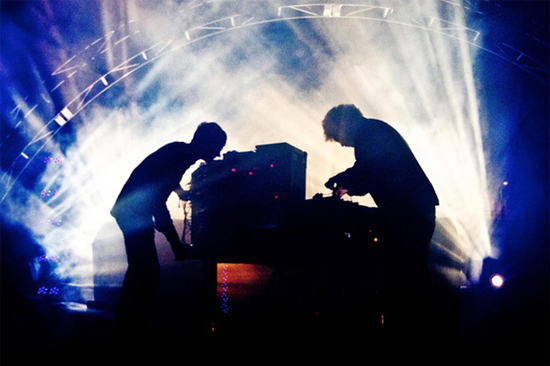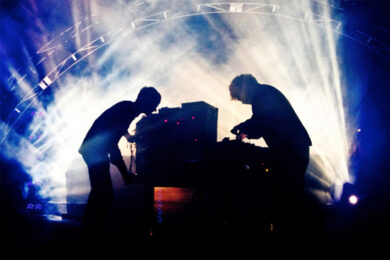Last year, electronic dance music big-hitter Deadmau5 wrote a now-infamous blog post, asserting that all electronic dance performers do is press play and let the computer do the rest. His own perspective – perhaps unsurprising for a stadium act – was that the most important factor in the live arena was environment, atmosphere, and his (extremely expensive) light show. In doing so he touched on a much debated and long-running question around the possibility of ‘live’ dance music, especially at a time when softwares such as Ableton allow for so many aspects of performance to be pre-programmed and automatically controlled.
He touched a nerve, and the incensed reaction from all corners of the dance music community (A Guy Called Gerald memorably called him a "greedy rat head fuck") highlighted the contentious and generalist nature of his statements. Indeed, there are as many different approaches to live dance music as there are live performers. For some, the quality of the audience experience is so paramount that the shows are almost entirely pre-programmed and synchronised to complex light displays (this group includes not only terminally uncool stadium-dance acts but also current critical darlings Daft Punk). Others see live music as music that poses the risk of failure, or music without a safety net, and therefore structure their sets to include greater or lesser opportunities for improvisation. For many artists this improvisational aspect might be linked specifically to the use of physical hardware – think Jeff Mills and his 909 jams, or the current rise in the use of hardware-only set ups among younger dance music producers. But equally, it’s not true that all laptop performance programs such as Ableton simply force their users into "just hitting play". Shackleton, for instance, arranges parts live in real-time using Ableton, creating unique sets for every performance. (Notably, after the blowback from ‘we all hit play’, Deadmau5 announced that he was working on a bespoke live music performance setup that would allow for a more improvisational show.)
But what of the quandaries presented by the live dance music album? Here, all too often, we have studio recordings dissected and recombined (to varying extents) in front of an audience, captured from the sound desk, and re-presented to the audience as a seamless new product. Where the live rock and roll album exists, at least in part, to prove that the musicians involved can indeed play their instruments and their own songs without the assistance of studio chicanery – with the odd bum note to ‘prove’ authenticity – there is no such raison d’être for the live dance album. Why would anyone listen to live versions of dance tracks when they have access to the studio versions?
Simian Mobile Disco’s Live offers one answer to that very question. Recorded in one take on the Philadelphia show of their 2012 US tour, with no edits, it exists not only as a document of one particular show, but also a document of how Simian Mobile Disco now see their past body of work. The duo use the elasticity of electronic music processes – the way that component sounds can be pulled apart, stretched, mutilated, and reassembled – to present a satisfyingly unified live concert, which stands in stark contrast to the surprising stylistic shifts that have marked their career. (For those of you who haven’t been keeping up: 2007’s Attack Decay Sustain Release, while not exactly of a piece with Justice’s † or Digitalism’s Idealism, sounds very much like a record released at the height of the blog-house moment; 2009’s Temporary Pleasures is a frothy confection of electro-pop; 2010’s Delicacies was high-strung, anxiety-making techno; and 2012’s Unpatterns was a kind of supple, understated house record.) Thus older tracks that, in their studio versions, now sound a little gauche – or have become faintly contemptible through familiarity – are given new life, as in the once-ubiquitous ‘Hustler’, which now comes across as a minimalist, acid-tinged techno banger.
Two other transformations deserve mentioning. First, ‘Cruel Intentions’, which has metamorphosed from its original form as diva-tastic radio fodder to a genuinely moving house anthem (mostly accomplished by slowing down Beth Ditto’s guest vocals and giving them more room to breathe with a stripped-back arrangement). Second, ‘Wooden’, one of the deep cuts from Attack Sustain Decay Release, which, once stripped of its abrasive, treble-heavy electro-house signifiers, reveals itself as something that might not sound out of place on Border Community now that James Holden has taken his analogue-synthesis-and-krautrock turn.
In using the live album as a means to draw connections between different areas of their past work, Simian Mobile Disco join the likes of Daft Punk and the Knife, both of whose live albums have forced audiences to reconsider the worth of work that they had previously perhaps maligned. (Those grousing about the level of excitement surrounding the release of Random Access Memories, in the wake of the general crappiness of Human After All, seemed to miss the point that Daft Punk’s current cachet stems directly from the success of their 2007 tour and its document, Alive 2007.)
The Quietus emailed Simian Mobile Disco – who answered questions in the plural – to discuss Live and what it means for their varied career.
The liner notes for Live indicate that it was "Recorded live in one take without edits". Why do you feel that it’s necessary to stress this fact? Would the recording lose some of its impact if it were revealed to be the product of stitching together several live recordings, or if it had been enriched with post-production?
Simian Mobile Disco: Yeah, exactly. We wanted this album to be a document of particular live show, a particular place in time and space. So totally opposite from a studio record, where you might have lots of takes, parts you can move from one place to another, edits, etc. We like that fact that it is a bit ruff around the edges.
Since this is a ‘live in one take’ album, what was the reasoning behind choosing this performance over any others? Do you feel that it was representative of the tour you were on, or was it exceptional? Could Live have come from any of the performances you gave last year (a la Daft Punk’s Alive 2007), or did each show have a different set list and relatively variable performances?
SMD: We recorded a number of the shows we played last year – not all of them, but a good chunk. This show is pretty representative, yeah – the setlist on our November/December tour was pretty much the same every night. But the way we play live is to have a load of different patterns in the drum machine, sequencers etc, so although the setlist was pretty fixed, the way we played those tracks changed every night. Depending on how we’re feeling, we can at different points extend the tracks into more or less freeform jams. If they’re going well, then we can just let them run for a bit – but if something goes awry, as is quite common with our gear (more on that in the next question) then we can look across the table at each other and know to kill the jam and move it onto the next track. So, in the end, this show was the one we liked best out of those we recorded – we felt our performance was the best, we managed to capture crowd noise (not always possible), and the crowd was really good.
What sort of equipment are you using to make music in the live setting these days? (I recall seeing you perform in Australia a few years ago with a circular analogue console that looked like it came straight from the BBC radiophonic workshop.) If it was created in a performance DAW like Ableton Live, was the audio captured from the club directly, or did you record the automation and render the audio later in-studio? If your live setup is entirely analogue, does this add an element of unpredictability to the live environment?
SMD: Our set up is based around, instrument wise, three analogue synths – the big Analogue Systems modular synth, that Jas spends most of his time in front of, and two smaller ones – a Dave Smith Prophet and a Doepfer Dark Energy, and then the [Roland] 909 for drums. We do have some digital stuff – two iPads and a launchpad that we use to trigger patterns via Ableton. But those are simply sending patterns to the analogue sequencer in the 909 and the analogue sequencer in the modular. So there’s no DAW automation to control – all the automation is real time, us twisting the knobs on the synth, and controlling all the outboard effects in real time into the mixer we have onstage. So the recording here is literally just what comes out of the stereo output of our mixer.
In answer to the second part, yes, having a bunch of analogue gear on stage definitely leads to an element of unpredictability – which is part of the attraction. Being slightly thrown by what the gear is doing forces you to be creative and adapt. Sometimes that can really generate some of our best performances …
A few of your earlier tracks that appear on this album have been radically reconfigured in the live context: ‘Cruel Intentions’ is slower and more stripped-back; the vocals of ‘Hustler’ have been pitch-shifted down, and generally everything sounds more in line with the edgier, less commercial SMD sound since the release of Delicacies. Are you repurposing old songs in the live environment to recontextualise them (show the connections between old and new), or to mess with peoples’ expectations?
SMD: To be honest, in the case of ‘Hustler’ the only element from the original track is the vocal! The rest of it is completely new sounds, you might want to call it a live ‘remix’ I suppose. But yeah, you have absolutely hit the nail on the head – we wanted to bring the older tracks into line with where we’re at currently, and to try and draw a link between old and new. It’s actually incredibly pleasing to hear that someone actually gets that!
In an age where nearly every live performance around the world is captured and disseminated by smartphone-wielding fans, and when it’s entirely feasible for an electronic music duo to release every one of their live shows as a digital-only ‘album’, why did you choose to cleave to the live album format? What is the significance of choosing one show from a tour, packaging up the recording, putting together the artwork, and releasing it as a standalone product?
SMD: Well … smartphone wielding fans can’t capture wav quality audio – at least not yet! We wanted to make a document of a particular instance from this tour. As we said above, it was a question of choosing the recording we felt went best from this tour. Our next tour will have a different setlist, there’ll be new music, things will get shifted around … I guess this tour is the first time we’ve tried to incorporate old and new music, and the chance to play with it over a run of few dates, so it felt that it was worth catching a snapshot of the live show as it is now.
Simian Mobile Disco’s Live is out now



